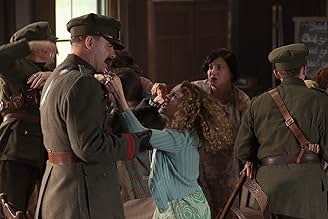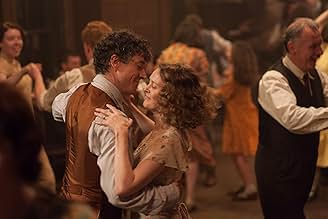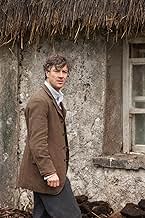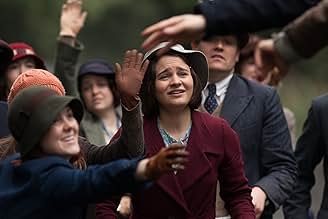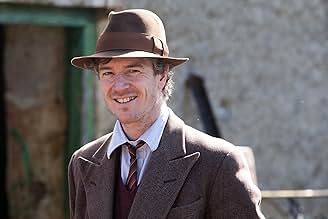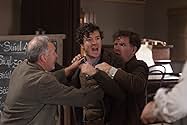Als Jimmy nach zehn Jahren US-Exil in seine Heimat Irland zurückkehrt, bestimmen noch immer der Pfarrer und der Gutsherr das Dorfleben. Um seinen Freunden Hoffnung zu geben, lädt Jimmy alle ... Alles lesenAls Jimmy nach zehn Jahren US-Exil in seine Heimat Irland zurückkehrt, bestimmen noch immer der Pfarrer und der Gutsherr das Dorfleben. Um seinen Freunden Hoffnung zu geben, lädt Jimmy alle in die bisher geschlossene Mehrzweckhalle ein.Als Jimmy nach zehn Jahren US-Exil in seine Heimat Irland zurückkehrt, bestimmen noch immer der Pfarrer und der Gutsherr das Dorfleben. Um seinen Freunden Hoffnung zu geben, lädt Jimmy alle in die bisher geschlossene Mehrzweckhalle ein.
- Auszeichnungen
- 2 Gewinne & 3 Nominierungen insgesamt
Empfohlene Bewertungen
One flaw in the movie is that people assume the struggle between Jimmy and the priest is communism versus the church. But Jimmy was not a communist. Jimmy was a grass-roots liberal who supported his community and occasionally spoke out against the concentration of power. The church represents this concentration of power and the struggle to maintain the concentration of power.
During the 1920's, a large percentage of the world's "Wealth" was tied up in speculative investments. Corrupt politicians sided with the land holders and the "Robber barons". By 1924, economic experts started to announce that unfettered greed would lead to an economic crisis in the USA and Europe. In 1929, the US stock-market crash vaporized much of the world's wealth and centralized power among an even smaller percentage of the population.
The movie includes a lot of history that most people in the US and UK who were born before 1977 already know. However, for most of the world, the Irish history and the extent of the struggle between the rich and poor during those times is new.
This struggle continues today. Instead of hereditary land owners, we have large banks and other institutions that "influence" most of the world's "capitalist" governments. The government favors for corporations and privatization of government services that starting in the late 1970's continues to this day and is responsible for the depression of 2008.
Without government support for those who were thrown into poverty, the 2008 depression would have been as bad as the 1929 depression. I think the writers were trying to remind us about the consequences of unfettered greed.
This film is naturally quite critical of the church's stranglehold on Irish life and policy. Jim Norton's role in portraying this is invaluable, after all who better to portray a controlling, traditionalist,angry priest than Bishop Brennan himself? Indeed, Jim's character in this film completely mirrors his character in Father Ted... but believe me, that is NOT a criticism.
While the movie may be slow-paced and seemingly dull at certain inter-sections, it's importance for history cannot be discounted. Not so long ago, it would have been sacrilege to watch this film due to it's unsubtle portrayal of the church's sometimes intrusive influence on Ireland, in fact some probably would still consider it to be so. It also deals with the rise of Fascism in Ireland in the early 20th century, something that is almost absent from cinema.
The movie deserves more credit and should have a larger influence than it appears to have. Give it a chance, some may call it propaganda... it's not. Give it a watch.
That said, the story bogs down in the second half of the film, making the staunchest advocate fidgety and anxious for some movement. It seems longer than the 1hr 49min advertised, but does not impinge on the gorgeous photography and the marvelous acting. Barry Ward as Jimmy was good, Simone Kirby was even better and Jim Norton as Fr. Sheridan was outstanding. I recommend "Jimmy's Hall", especially if you went to school in the U.S. - I guarantee you will be enlightened.
How did he do that? He set up a dance hall, how scandalous. Whilst by and large the locals embraced it and it provided them with a focal point there was opposition. The church led the way, and some local conservatives followed. By branding them as communists provided their arguments with some supposed gravity. What went on in that hall was open for all to see, yet it met with fierce opposition.
The film puts the two worlds into focus. One view is that change is reprehensible, things ought to stay as they are. The opposing view wants change, people to be free from oppression. The newcomer brought some new ideologies as well as lots of controversy.
Both sides are unchangeable in their positions, no one is prepared to backtrack and a clash is unavoidable. Can the idealist modernist challenge the ultra powerful church orthodoxy?
A mighty tale about old and new in the battlefield of ideas.
It deals with the very specific conflict between those who opposed the Treaty, those who supported it and the dominating Catholic Church when one, Jimmy Gralton, returns from 10 years exile in America and reopens a community hall that was the source of all his trouble in the first place, against the express wishes of 'Holy Mother Church' and those who backed it.
As scripted by Paul Laverty it is, of course, a deeply political film but Loach is the most humanist of political film-makers; consequently it is also a deeply moving (and, at times, very funny) picture. At its centre is a magnificent performance from Barry Ward as Gralton and he is backed beautifully by Jim Norton and Andrew Scott representing the clergy as well as a host of wonderfully naturalistic Irish actors, some professional, some not. Loach may now be in this seventies but this feels as fresh and as relevant as anything he did fifty years ago. I think it's the equal to both "Land and Freedom" and "The Wind that Shakes the Barley".
Wusstest du schon
- WissenswertesThe real Jimmy Gralton was the only Irishman ever deported from Ireland after Irish Independence. After the release of the film, a 2015 campaign (including an online petition) was started with the aim to rescind the deportation order and extend an official apology to his family. In 2016, this resulted in the President of Ireland stating the only deportation of an Irishman from Ireland was "wrong and indefensible." He unveiled a Gralton memorial at Effrinagh outside Carrick-on-Shannon, on the site where the hall once stood. The stone edifice, which tells Gralton's life story as a labor campaigner, was partially funded by the trade union movement.
- PatzerThe prologue claims the people of Ireland fought for independence from the British Empire from 1919 to 1921. However Ireland was actually part of the UK until 6 December 1922, only becoming a Dominion of the British Empire when the Anglo-Irish Treaty came into effect.
- Zitate
James Gralton: We need to take control of our lives again. Work for need, not for greed. And not just to survive like a dog, but to live. And to celebrate. And to dance, to sing, as free human beings.
- Crazy CreditsAt the end of a long list of people and organizations under the heading "Thank You" in the end credits, Dixie the horse, Cabundie the donkey, and Homer the three-legged dog are mentioned.
- VerbindungenFeatured in La noche de...: Jimmy's Hall (2017)
- SoundtracksSugar Foot Strut
Written by Harry Myers, Billie Pierce, Charles Schwab, Georges Matis
Used by kind permission of Carlin Music Corp.
Performed by Louis Armstrong & His Savoy Ballroom Five
courtesy of Sony Music Entertainment Inc.
Top-Auswahl
- How long is Jimmy's Hall?Powered by Alexa
Details
- Erscheinungsdatum
- Herkunftsländer
- Offizielle Standorte
- Sprachen
- Auch bekannt als
- Özgürlük Dansı
- Drehorte
- Killanummery, Co. Leitrim, Irland(Jimmy's Hall and surroundings)
- Produktionsfirmen
- Weitere beteiligte Unternehmen bei IMDbPro anzeigen
Box Office
- Budget
- 6.911.962 € (geschätzt)
- Bruttoertrag in den USA und Kanada
- 560.592 $
- Eröffnungswochenende in den USA und in Kanada
- 19.881 $
- 5. Juli 2015
- Weltweiter Bruttoertrag
- 4.825.184 $
- Laufzeit
- 1 Std. 49 Min.(109 min)
- Farbe
- Sound-Mix
- Seitenverhältnis
- 1.85 : 1



